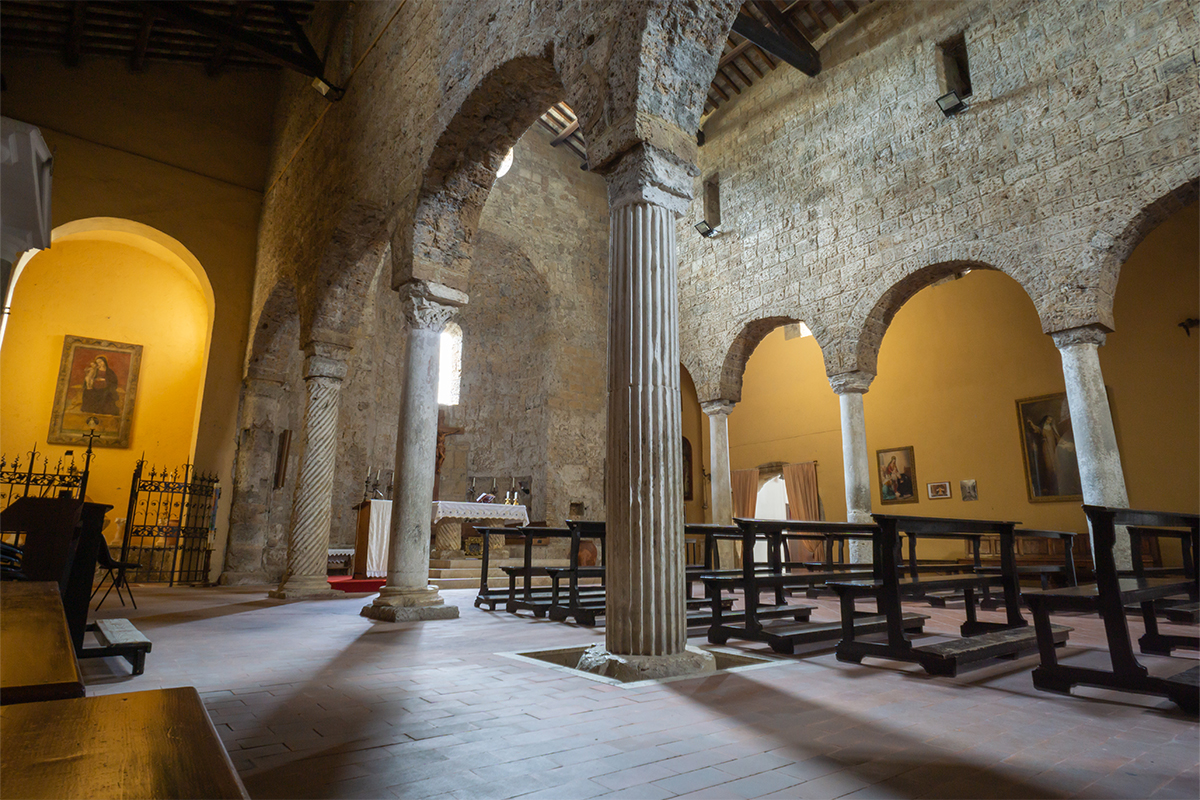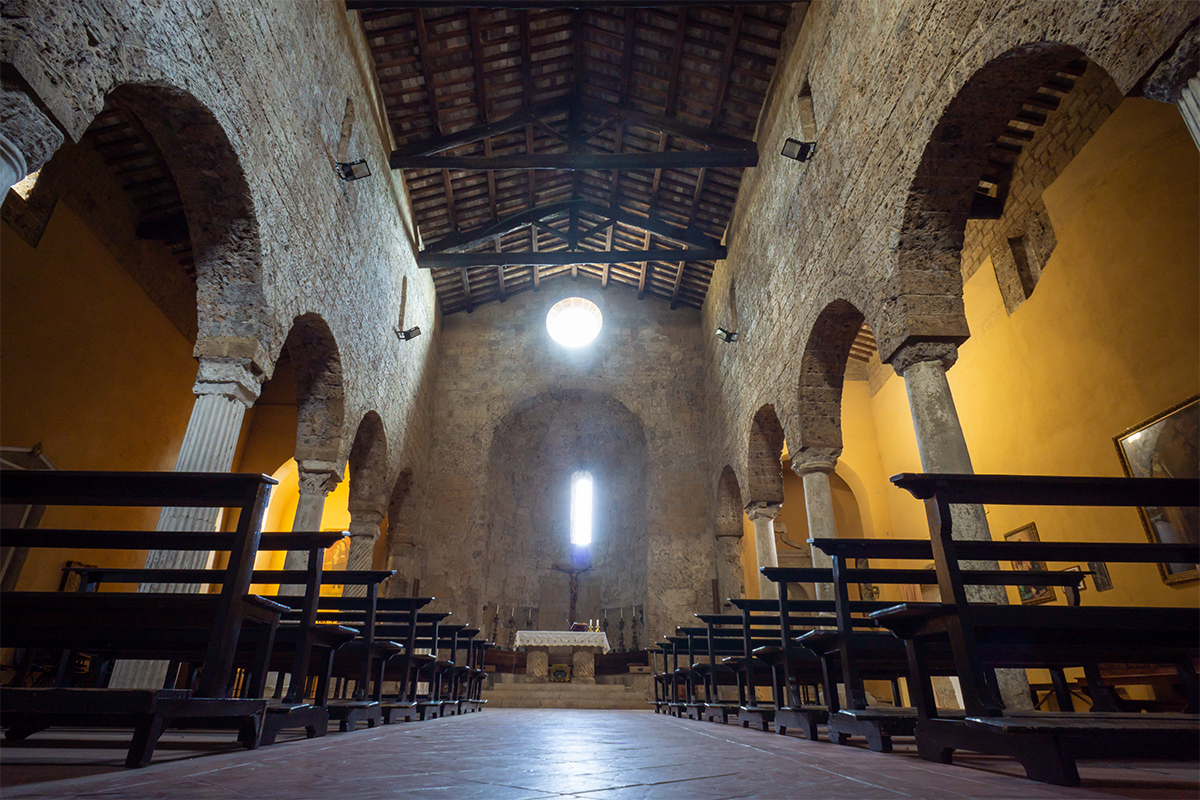Church of Santa Maria Maggiore in Cerveteri: What to see
Find out what to see in the Church of Santa Maria Maggiore in Cerveteri: history, works, architecture and much more.Right in the historic center of Cerveteri, near Palazzo Ruspoli and the National Archaeological Museum, is one of the oldest churches in the city: the Church of Santa Maria Maggiore.
Today is the main church and it is divided into two parts:
- a historical one, from around 1100,
- a new one, built in the 1950s.
Together, the two churches form the unique complex of the archpriesthood of Cerveteri. Let's start to discover the origins and what to see in the Church of Santa Maria Maggiore.

Interior of Santa Maria Maggiore' s church, in Cerveteri
A bit of history
It became a church probably just after the edict of Constantine, in the 3rd century A.D. However, the place of worship, as it is preserved today, was built around the year 1000.
The foundations of the building consist of large square blocks of tufa. For this reason, it is possible that the church was built on the site of an Etruscan temple.
A crucial moment occurred in 1674, when Cerveteri underwent its last change of ownership before the Unification of Italy: from the Orsini family it passed to the Ruspoli family, who, renovating the baronial palace, transformed the church of Santa Maria Maggiore into their private chapel, with subsequent changes to its appearance, until the 1950s.
Here the most relevant changes:
- Encapsulation of columns in stone-clad brick pillars;
- Painting of walls;
- Opening of the quadrangular windows on the minor aisles, bringing the church to a total number of five altars.
In 1703, the church was restored in several parts and, shortly after 1719, the door of the left nave, next to the old baptistery, was opened.
On September 30, 1707, the Ruspoli family wrote a letter to Cardinal Niccolò Acciaioli, bishop of Porto and Santa Rufina, which said: ".... Francesco Maria Ruspoli requests permission to build a bridge in the alley, so that a hole can be built inside the main door so that they can hear masses more easily...". The license was given shortly after.
This bridge, called "passetto", still exists. It ended with a door, today converted into a loophole, which allowed the Ruspoli family to attend mass from the palace, through the balcony.
Numerous restorations were carried out in the 19th century: in 1817 the windows, in 1852 the façade and matroneo, in 1861 the roof and in 1879 a more general restoration.
In 1952, under the direction of the architect Giorgio Romanini, the church reverted to its original Romanesque style for enlargement works.
In 1959 the church was expanded with a longitudinal body of three naves, thus reducing the old church to a kind of transept: the great arch that united the two churches, however, has been closed since 2009, in order to build an altar to house the painting by Lorenzo da Viterbo.

Church of Santa Maria Maggiore in Cerveteri
Church of Santa Maria Maggiore a Cerveteri: What to see
In the central apse you can see the spaces where the seats for the diocesan clergy were located.
Not to be missed, in the left nave, are the remains of the cosmatesque pavement dated 1231, which came to light during the restoration of 1950.
Inside, there are wonderful frescoes, including "Madonna and Child", by an anonymous painter of the 15th century, and "The Pietà", also by unknown painters, from the church of San Martino, now demolished.
Unfortunately, one of the most important works of the church, dating from 1472, is no longer present there. It is the panel of the "Madonna in Trono col Bambino tra San Michele e San Pietro", by the painter Lorenzo da Viterbo. Instead, it can be admired in the National Gallery of Ancient Art of Palazzo Barberini in Rome.
Another work that deserves special mention is undoubtedly the Romanesque-style bell tower, located between the church and Palazzo Ruspoli. It has a square structure and is divided into planes by frames, with a mullioned window on each side.
Built in 1760, together with the Ruspoli palace, it has four large single-leaf windows. There are currently three bells:
- a small one on the right, dedicated to the crucifix, made by Francesco Lucenti in 1982;
- a medium one on the left, the oldest one, dedicated to St. Mary, cast by Paolino de Bossis in 1517
- the large bell, dedicated to St. Mary, in the center, cast by Paolino de Bossis in 1507 and recast by Camillo Lucenti in 1948.

Interior of the "old" church
The new church: What to see
During World War II, the citizens asked the Virgin Mary to save their city from bombing and promised to build a new church in her honor.
These were the motivations that led to the foundation of the present church. Thus, on October 12, 1959, the new church of Santa Maria Maggiore was consecrated by Cardinal Eugenio Tisserant, cardinal bishop of the diocese of Porto and Santa Rufina.
The facade is in neo-Romanesque style, and there is a beautiful rose window and fourteen monophoria windows, which illuminate the interior. The church is divided into three naves covered with a trussed roof, with five columns. Several statues of saints can also be admired.
This is all you need to know about the Church of Santa Maria in Cerveteri... Now you just have to visit it!
READ ALSO: CERVETERI AND THE NECROPOLIS OF BANDITACCIA
Useful information
- TIMETABLES
Check the official website
- PRICES
free entrance



 PORT MOBILITY CIVITAVECCHIA
PORT MOBILITY CIVITAVECCHIA












